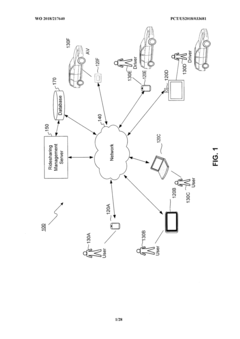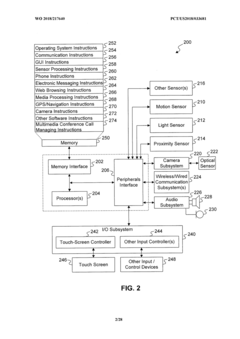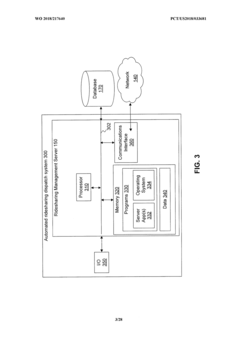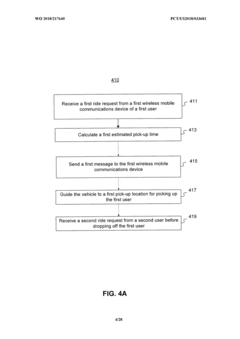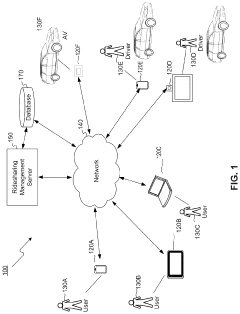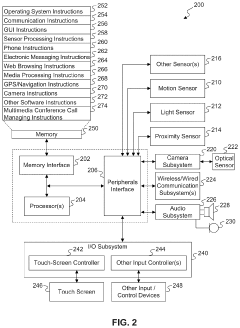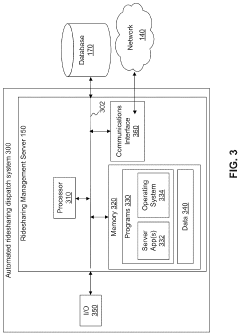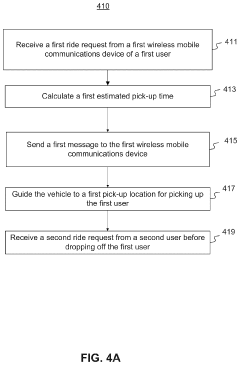How Throttle Body Technology Supports Car Sharing Services
JUL 18, 20259 MIN READ
Generate Your Research Report Instantly with AI Agent
Patsnap Eureka helps you evaluate technical feasibility & market potential.
Throttle Body Evolution
The evolution of throttle body technology has played a significant role in supporting the growth and efficiency of car sharing services. This progression can be traced through several key stages, each marking important advancements that have contributed to the improved performance, fuel efficiency, and overall reliability of shared vehicles.
In the early days of automotive technology, mechanical throttle bodies were the standard. These systems relied on a direct physical connection between the accelerator pedal and the throttle plate, using cables or linkages. While functional, they lacked precision and were prone to wear and tear, making them less than ideal for the high-usage demands of car sharing fleets.
The introduction of electronic throttle control (ETC) systems, also known as drive-by-wire technology, marked a significant leap forward. This innovation replaced mechanical linkages with electronic sensors and actuators, allowing for more precise control of the engine's air intake. For car sharing services, this meant improved fuel efficiency, smoother acceleration, and reduced maintenance needs – all crucial factors in managing large fleets of shared vehicles.
As ETC systems evolved, they began to incorporate more advanced features such as adaptive learning algorithms. These systems could adjust throttle response based on driving conditions and driver behavior, further enhancing the driving experience for car sharing users who may not be familiar with a particular vehicle model.
The integration of throttle body technology with other vehicle systems has been another key development. Modern throttle bodies now communicate with engine control units (ECUs), transmission control modules, and even advanced driver assistance systems (ADAS). This integration allows for more sophisticated control strategies, such as optimizing throttle response for different driving modes or adjusting performance based on vehicle load – features that are particularly beneficial in the diverse usage scenarios of car sharing.
Recent advancements have seen the emergence of smart throttle bodies equipped with IoT capabilities. These systems can transmit real-time data on vehicle performance and usage patterns, providing valuable insights for car sharing operators. This data can be used to optimize fleet management, predict maintenance needs, and even tailor the driving experience for individual users.
The latest frontier in throttle body evolution is the development of AI-enhanced systems. These cutting-edge technologies use machine learning algorithms to continuously improve throttle response and engine performance based on aggregated data from entire fleets of shared vehicles. This not only enhances the driving experience but also contributes to improved fuel efficiency and reduced emissions across the entire car sharing network.
As we look to the future, the ongoing evolution of throttle body technology promises to bring even greater benefits to car sharing services. Innovations in materials science and miniaturization are likely to lead to more compact, durable, and efficient throttle bodies, while advancements in AI and connectivity will further enhance their ability to optimize performance in real-time, supporting the growing demands of the shared mobility ecosystem.
In the early days of automotive technology, mechanical throttle bodies were the standard. These systems relied on a direct physical connection between the accelerator pedal and the throttle plate, using cables or linkages. While functional, they lacked precision and were prone to wear and tear, making them less than ideal for the high-usage demands of car sharing fleets.
The introduction of electronic throttle control (ETC) systems, also known as drive-by-wire technology, marked a significant leap forward. This innovation replaced mechanical linkages with electronic sensors and actuators, allowing for more precise control of the engine's air intake. For car sharing services, this meant improved fuel efficiency, smoother acceleration, and reduced maintenance needs – all crucial factors in managing large fleets of shared vehicles.
As ETC systems evolved, they began to incorporate more advanced features such as adaptive learning algorithms. These systems could adjust throttle response based on driving conditions and driver behavior, further enhancing the driving experience for car sharing users who may not be familiar with a particular vehicle model.
The integration of throttle body technology with other vehicle systems has been another key development. Modern throttle bodies now communicate with engine control units (ECUs), transmission control modules, and even advanced driver assistance systems (ADAS). This integration allows for more sophisticated control strategies, such as optimizing throttle response for different driving modes or adjusting performance based on vehicle load – features that are particularly beneficial in the diverse usage scenarios of car sharing.
Recent advancements have seen the emergence of smart throttle bodies equipped with IoT capabilities. These systems can transmit real-time data on vehicle performance and usage patterns, providing valuable insights for car sharing operators. This data can be used to optimize fleet management, predict maintenance needs, and even tailor the driving experience for individual users.
The latest frontier in throttle body evolution is the development of AI-enhanced systems. These cutting-edge technologies use machine learning algorithms to continuously improve throttle response and engine performance based on aggregated data from entire fleets of shared vehicles. This not only enhances the driving experience but also contributes to improved fuel efficiency and reduced emissions across the entire car sharing network.
As we look to the future, the ongoing evolution of throttle body technology promises to bring even greater benefits to car sharing services. Innovations in materials science and miniaturization are likely to lead to more compact, durable, and efficient throttle bodies, while advancements in AI and connectivity will further enhance their ability to optimize performance in real-time, supporting the growing demands of the shared mobility ecosystem.
Car Sharing Market Trends
The car sharing market has experienced significant growth in recent years, driven by changing consumer preferences, urbanization, and environmental concerns. This trend is expected to continue, with the global car sharing market projected to reach $20 billion by 2025, growing at a CAGR of over 24% from 2020 to 2025.
One of the key factors fueling this growth is the increasing adoption of car sharing services in urban areas. As cities become more congested and parking spaces become scarce, consumers are turning to car sharing as a convenient and cost-effective alternative to car ownership. This shift is particularly pronounced among younger generations, who prioritize access over ownership and are more environmentally conscious.
The rise of electric vehicles (EVs) is also playing a crucial role in shaping the car sharing market. Many car sharing companies are incorporating EVs into their fleets to reduce operational costs and appeal to environmentally conscious consumers. This trend is expected to accelerate as EV technology improves and charging infrastructure expands.
Technology advancements are significantly impacting the car sharing industry. The integration of mobile apps, GPS tracking, and keyless entry systems has made car sharing more user-friendly and efficient. These technologies enable seamless booking, vehicle location, and access, enhancing the overall user experience.
The COVID-19 pandemic has had a mixed impact on the car sharing market. While initial lockdowns and travel restrictions led to a temporary decline in usage, the industry has shown resilience and adaptability. Many car sharing companies have implemented enhanced cleaning protocols and contactless services to address safety concerns, which has helped in regaining consumer confidence.
Corporate car sharing is emerging as a growing segment within the market. Companies are increasingly adopting car sharing solutions to optimize their fleet management and reduce transportation costs. This trend is expected to contribute significantly to market growth in the coming years.
Geographically, North America and Europe currently dominate the car sharing market, but Asia-Pacific is expected to witness the fastest growth. Rapid urbanization, increasing traffic congestion, and government initiatives promoting shared mobility in countries like China and India are driving this growth.
One of the key factors fueling this growth is the increasing adoption of car sharing services in urban areas. As cities become more congested and parking spaces become scarce, consumers are turning to car sharing as a convenient and cost-effective alternative to car ownership. This shift is particularly pronounced among younger generations, who prioritize access over ownership and are more environmentally conscious.
The rise of electric vehicles (EVs) is also playing a crucial role in shaping the car sharing market. Many car sharing companies are incorporating EVs into their fleets to reduce operational costs and appeal to environmentally conscious consumers. This trend is expected to accelerate as EV technology improves and charging infrastructure expands.
Technology advancements are significantly impacting the car sharing industry. The integration of mobile apps, GPS tracking, and keyless entry systems has made car sharing more user-friendly and efficient. These technologies enable seamless booking, vehicle location, and access, enhancing the overall user experience.
The COVID-19 pandemic has had a mixed impact on the car sharing market. While initial lockdowns and travel restrictions led to a temporary decline in usage, the industry has shown resilience and adaptability. Many car sharing companies have implemented enhanced cleaning protocols and contactless services to address safety concerns, which has helped in regaining consumer confidence.
Corporate car sharing is emerging as a growing segment within the market. Companies are increasingly adopting car sharing solutions to optimize their fleet management and reduce transportation costs. This trend is expected to contribute significantly to market growth in the coming years.
Geographically, North America and Europe currently dominate the car sharing market, but Asia-Pacific is expected to witness the fastest growth. Rapid urbanization, increasing traffic congestion, and government initiatives promoting shared mobility in countries like China and India are driving this growth.
Throttle Tech Challenges
The integration of throttle body technology in car sharing services presents several technical challenges that need to be addressed for optimal performance and user experience. One of the primary challenges is the need for precise and responsive throttle control across a diverse fleet of vehicles. Car sharing services often operate with a wide range of vehicle models, each with its own unique throttle characteristics. Developing a standardized throttle body system that can adapt to various vehicle types while maintaining consistent performance is a significant technical hurdle.
Another challenge lies in the remote monitoring and diagnostics of throttle body systems in shared vehicles. As these vehicles are used by multiple drivers with varying driving styles, the throttle bodies are subjected to increased wear and potential malfunctions. Implementing robust telemetry systems to track throttle performance, detect anomalies, and predict maintenance needs becomes crucial for ensuring service reliability and user safety.
The integration of throttle body technology with advanced driver assistance systems (ADAS) and autonomous driving features poses additional complexities. Car sharing services are increasingly incorporating these technologies to enhance safety and user convenience. However, ensuring seamless communication and coordination between the throttle control system and other vehicle subsystems requires sophisticated software integration and real-time data processing capabilities.
Fuel efficiency optimization is another critical challenge in the context of car sharing services. The throttle body plays a vital role in managing fuel consumption, and developing adaptive algorithms that can optimize throttle response based on different driving conditions and user behaviors is essential for reducing operational costs and environmental impact.
Furthermore, the security of throttle body systems in shared vehicles is a growing concern. As these systems become more connected and software-driven, they become potential targets for cyber attacks. Implementing robust security measures to prevent unauthorized access or manipulation of throttle controls is crucial for maintaining the integrity and safety of the car sharing fleet.
Lastly, the durability and longevity of throttle body components in the high-usage environment of car sharing services present significant engineering challenges. Designing throttle systems that can withstand frequent use by multiple drivers, varying environmental conditions, and minimal downtime for maintenance requires innovative materials and manufacturing techniques.
Another challenge lies in the remote monitoring and diagnostics of throttle body systems in shared vehicles. As these vehicles are used by multiple drivers with varying driving styles, the throttle bodies are subjected to increased wear and potential malfunctions. Implementing robust telemetry systems to track throttle performance, detect anomalies, and predict maintenance needs becomes crucial for ensuring service reliability and user safety.
The integration of throttle body technology with advanced driver assistance systems (ADAS) and autonomous driving features poses additional complexities. Car sharing services are increasingly incorporating these technologies to enhance safety and user convenience. However, ensuring seamless communication and coordination between the throttle control system and other vehicle subsystems requires sophisticated software integration and real-time data processing capabilities.
Fuel efficiency optimization is another critical challenge in the context of car sharing services. The throttle body plays a vital role in managing fuel consumption, and developing adaptive algorithms that can optimize throttle response based on different driving conditions and user behaviors is essential for reducing operational costs and environmental impact.
Furthermore, the security of throttle body systems in shared vehicles is a growing concern. As these systems become more connected and software-driven, they become potential targets for cyber attacks. Implementing robust security measures to prevent unauthorized access or manipulation of throttle controls is crucial for maintaining the integrity and safety of the car sharing fleet.
Lastly, the durability and longevity of throttle body components in the high-usage environment of car sharing services present significant engineering challenges. Designing throttle systems that can withstand frequent use by multiple drivers, varying environmental conditions, and minimal downtime for maintenance requires innovative materials and manufacturing techniques.
Current Throttle Solutions
01 Throttle body design and construction
Throttle bodies are designed to control airflow into an engine's intake manifold. They typically consist of a housing with a butterfly valve that can be opened or closed to regulate air intake. Various designs focus on improving airflow efficiency, reducing turbulence, and enhancing overall engine performance.- Throttle body design and construction: Throttle bodies are designed with various features to improve engine performance and efficiency. This includes optimizing airflow, incorporating sensors for precise control, and using materials that enhance durability and reduce weight. Some designs focus on reducing turbulence and improving throttle response.
- Electronic throttle control systems: Modern throttle bodies often incorporate electronic control systems. These systems use sensors and actuators to precisely regulate airflow based on various engine parameters and driver input. This allows for improved fuel efficiency, emissions control, and overall engine performance.
- Idle air control mechanisms: Throttle bodies may include idle air control mechanisms to regulate engine speed during idle conditions. These mechanisms can be integrated into the throttle body or exist as separate components. They help maintain stable idle speeds and improve engine efficiency at low loads.
- Throttle position sensors: Throttle position sensors are crucial components in modern throttle bodies. These sensors provide feedback on the throttle plate's position to the engine control unit, allowing for precise fuel injection and ignition timing adjustments. This results in improved engine performance and fuel efficiency.
- Throttle body cleaning and maintenance: Throttle bodies require regular cleaning and maintenance to ensure optimal performance. Carbon buildup and debris can affect throttle response and airflow. Some designs incorporate features to facilitate easier cleaning or reduce carbon accumulation, while others focus on improving overall durability to minimize maintenance needs.
02 Electronic throttle control systems
Modern throttle bodies often incorporate electronic control systems, replacing traditional mechanical linkages. These systems use sensors and actuators to precisely control throttle position based on various engine parameters and driver input, improving fuel efficiency and engine response.Expand Specific Solutions03 Idle air control mechanisms
Throttle bodies may include idle air control mechanisms to regulate engine idle speed. These systems bypass the main throttle plate to provide a controlled amount of air during idle conditions, ensuring stable engine operation and smooth transitions between idle and acceleration.Expand Specific Solutions04 Throttle body cleaning and maintenance
Throttle bodies can accumulate carbon deposits and other contaminants over time, affecting performance. Various cleaning methods and maintenance procedures are developed to keep throttle bodies functioning optimally, including specialized cleaning solutions and tools for removing buildup without damaging sensitive components.Expand Specific Solutions05 Integration with fuel injection systems
Throttle bodies are often integrated with fuel injection systems to optimize air-fuel mixture. This integration can involve positioning fuel injectors near the throttle body, incorporating fuel rails, or designing throttle bodies that work in conjunction with direct injection systems for improved atomization and combustion efficiency.Expand Specific Solutions
Key Automotive Players
The throttle body technology market supporting car sharing services is in a growth phase, driven by increasing demand for efficient and eco-friendly transportation solutions. The market size is expanding as more automotive manufacturers and technology companies invest in this area. Technologically, the field is advancing rapidly, with companies like Honda, Hyundai, and Kia leading innovation. Via Transportation and Zoox are leveraging throttle body technology to enhance their car-sharing platforms, while suppliers such as Continental Automotive and Mitsubishi Electric are developing advanced throttle control systems. The integration of IoT and AI technologies by firms like Shanghai Pateo is further accelerating the maturity of throttle body solutions for car sharing applications.
Hyundai Motor Co., Ltd.
Technical Solution: Hyundai has developed a smart throttle control system specifically designed for car sharing services. This system incorporates machine learning algorithms to adapt throttle response based on individual driving patterns and preferences[4]. For car sharing applications, Hyundai's throttle technology interfaces with their BlueLink connected car system, allowing for real-time throttle adjustments and performance monitoring[5]. The system also includes a predictive maintenance feature that analyzes throttle behavior to anticipate potential issues before they affect vehicle operation. Hyundai has implemented a secure, blockchain-based authentication system to ensure that only authorized users can access and modify throttle settings in shared vehicles[6].
Strengths: Personalized driving experience, predictive maintenance capabilities, and enhanced security. Weaknesses: Reliance on continuous connectivity and potential privacy concerns regarding data collection.
Toyota Motor Corp.
Technical Solution: Toyota has developed an advanced electronic throttle control system (ETCS-i) that supports car sharing services by enhancing fuel efficiency and vehicle performance. This system uses sensors to detect the accelerator pedal position and vehicle operating conditions, then calculates the optimal throttle opening[1]. For car sharing, Toyota has integrated this technology with their connected car platform, allowing for remote throttle control and diagnostics[2]. This enables car sharing operators to monitor vehicle performance, adjust throttle response for different drivers, and optimize fuel consumption across their fleet. Toyota has also implemented a fail-safe mechanism that ensures the throttle returns to idle position in case of system malfunction, enhancing safety for shared vehicles[3].
Strengths: Improved fuel efficiency, enhanced vehicle performance, and remote diagnostics capabilities. Weaknesses: Potential for increased complexity and higher maintenance costs for car sharing fleets.
Throttle Innovations
Systems and methods for managing ridesharing vehicles
PatentWO2018217640A1
Innovation
- A system that uses GPS data, battery charge levels, and charging station occupancy to select a charging station for electric vehicles, optimizing routes to ensure efficient charging and passenger transport by selecting stations based on predicted demand and capacity, while also adjusting routes to include charging stops as necessary.
Prescheduling a rideshare with an unknown pick-up location
PatentActiveUS11830363B2
Innovation
- The implementation of a system that includes sensors in vehicles to accurately count passengers, processors to compare scheduled and actual passenger numbers, and a centralized management system that directs electric vehicles to charging stations based on historical demand data and current battery levels, optimizing routes to ensure vehicles are charged in time for peak demand periods.
Fuel Efficiency Impact
The impact of throttle body technology on fuel efficiency in car sharing services is significant and multifaceted. Advanced throttle body systems play a crucial role in optimizing fuel consumption, which is particularly important for car sharing fleets where operational costs and environmental considerations are paramount.
Modern throttle bodies utilize electronic control systems that precisely regulate air intake into the engine. This level of control allows for more accurate fuel metering, resulting in improved combustion efficiency. In the context of car sharing services, where vehicles are used by multiple drivers with varying driving styles, adaptive throttle body systems can help maintain consistent fuel efficiency across different usage patterns.
The integration of throttle body technology with other vehicle systems, such as engine control units (ECUs) and transmission control modules, enables a holistic approach to fuel management. This synergy allows for real-time adjustments based on driving conditions, vehicle load, and even predictive data from navigation systems. For car sharing fleets, this translates to optimized fuel consumption across diverse urban and highway environments.
Furthermore, throttle body innovations have led to the development of idle-stop systems, which automatically shut off the engine when the vehicle is stationary. This feature is particularly beneficial in urban car sharing scenarios, where frequent stops are common. By reducing unnecessary idling, these systems can significantly decrease fuel consumption and emissions in city traffic.
The incorporation of throttle-by-wire technology in modern vehicles has eliminated the need for mechanical linkages between the accelerator pedal and the throttle body. This not only reduces weight but also allows for more precise control over throttle response. In car sharing applications, this technology can be programmed to favor fuel-efficient driving patterns, gently modulating acceleration to discourage aggressive driving behaviors that typically lead to higher fuel consumption.
Advanced throttle bodies also contribute to improved cold-start efficiency, a critical factor in short-trip scenarios common in car sharing. By optimizing air-fuel mixtures during engine warm-up phases, these systems reduce the period of increased fuel consumption associated with cold engines, leading to better overall efficiency in shared vehicle fleets.
The data collected from throttle body sensors can be invaluable for car sharing service providers. By analyzing throttle position, air intake, and fuel consumption patterns, companies can gain insights into vehicle usage, driver behavior, and potential maintenance needs. This data-driven approach enables proactive fleet management and targeted efficiency improvements.
Modern throttle bodies utilize electronic control systems that precisely regulate air intake into the engine. This level of control allows for more accurate fuel metering, resulting in improved combustion efficiency. In the context of car sharing services, where vehicles are used by multiple drivers with varying driving styles, adaptive throttle body systems can help maintain consistent fuel efficiency across different usage patterns.
The integration of throttle body technology with other vehicle systems, such as engine control units (ECUs) and transmission control modules, enables a holistic approach to fuel management. This synergy allows for real-time adjustments based on driving conditions, vehicle load, and even predictive data from navigation systems. For car sharing fleets, this translates to optimized fuel consumption across diverse urban and highway environments.
Furthermore, throttle body innovations have led to the development of idle-stop systems, which automatically shut off the engine when the vehicle is stationary. This feature is particularly beneficial in urban car sharing scenarios, where frequent stops are common. By reducing unnecessary idling, these systems can significantly decrease fuel consumption and emissions in city traffic.
The incorporation of throttle-by-wire technology in modern vehicles has eliminated the need for mechanical linkages between the accelerator pedal and the throttle body. This not only reduces weight but also allows for more precise control over throttle response. In car sharing applications, this technology can be programmed to favor fuel-efficient driving patterns, gently modulating acceleration to discourage aggressive driving behaviors that typically lead to higher fuel consumption.
Advanced throttle bodies also contribute to improved cold-start efficiency, a critical factor in short-trip scenarios common in car sharing. By optimizing air-fuel mixtures during engine warm-up phases, these systems reduce the period of increased fuel consumption associated with cold engines, leading to better overall efficiency in shared vehicle fleets.
The data collected from throttle body sensors can be invaluable for car sharing service providers. By analyzing throttle position, air intake, and fuel consumption patterns, companies can gain insights into vehicle usage, driver behavior, and potential maintenance needs. This data-driven approach enables proactive fleet management and targeted efficiency improvements.
Connectivity Integration
The integration of connectivity features into throttle body technology plays a crucial role in supporting car sharing services. This integration enables real-time communication between the vehicle's engine management system and the car sharing platform, facilitating seamless operation and enhanced user experience.
Connectivity integration in throttle body systems allows for remote monitoring and control of vehicle performance. Car sharing service providers can access vital engine data, including fuel consumption, throttle position, and overall engine health. This information helps in predictive maintenance, reducing unexpected breakdowns and improving vehicle availability for users.
The connected throttle body also enables dynamic adjustment of engine performance based on user preferences or service requirements. For instance, the system can limit engine power for novice drivers or optimize fuel efficiency for eco-conscious users. This adaptability enhances safety and customization options for car sharing services.
Furthermore, connectivity integration supports advanced security features. The throttle body can be electronically controlled to prevent unauthorized vehicle use, acting as an additional layer of protection alongside traditional key-based systems. This is particularly valuable in car sharing scenarios where multiple users access the same vehicle.
Real-time data transmission from the throttle body to the car sharing platform allows for accurate billing based on actual vehicle usage. The system can precisely measure factors such as acceleration patterns and engine load, providing a fair and transparent pricing model for users.
The integration also facilitates over-the-air updates for the throttle body control software. This capability ensures that the vehicle's performance can be continuously optimized without requiring physical access, reducing maintenance downtime and improving overall fleet efficiency.
Connectivity in throttle body systems supports advanced diagnostics capabilities. Car sharing operators can remotely identify and often resolve issues related to engine performance, reducing the need for physical inspections and minimizing service disruptions.
Lastly, the connected throttle body contributes to improved fleet management. By providing real-time data on vehicle location, status, and performance, it enables car sharing services to optimize vehicle distribution and respond quickly to changing demand patterns, ultimately enhancing service quality and operational efficiency.
Connectivity integration in throttle body systems allows for remote monitoring and control of vehicle performance. Car sharing service providers can access vital engine data, including fuel consumption, throttle position, and overall engine health. This information helps in predictive maintenance, reducing unexpected breakdowns and improving vehicle availability for users.
The connected throttle body also enables dynamic adjustment of engine performance based on user preferences or service requirements. For instance, the system can limit engine power for novice drivers or optimize fuel efficiency for eco-conscious users. This adaptability enhances safety and customization options for car sharing services.
Furthermore, connectivity integration supports advanced security features. The throttle body can be electronically controlled to prevent unauthorized vehicle use, acting as an additional layer of protection alongside traditional key-based systems. This is particularly valuable in car sharing scenarios where multiple users access the same vehicle.
Real-time data transmission from the throttle body to the car sharing platform allows for accurate billing based on actual vehicle usage. The system can precisely measure factors such as acceleration patterns and engine load, providing a fair and transparent pricing model for users.
The integration also facilitates over-the-air updates for the throttle body control software. This capability ensures that the vehicle's performance can be continuously optimized without requiring physical access, reducing maintenance downtime and improving overall fleet efficiency.
Connectivity in throttle body systems supports advanced diagnostics capabilities. Car sharing operators can remotely identify and often resolve issues related to engine performance, reducing the need for physical inspections and minimizing service disruptions.
Lastly, the connected throttle body contributes to improved fleet management. By providing real-time data on vehicle location, status, and performance, it enables car sharing services to optimize vehicle distribution and respond quickly to changing demand patterns, ultimately enhancing service quality and operational efficiency.
Unlock deeper insights with Patsnap Eureka Quick Research — get a full tech report to explore trends and direct your research. Try now!
Generate Your Research Report Instantly with AI Agent
Supercharge your innovation with Patsnap Eureka AI Agent Platform!
